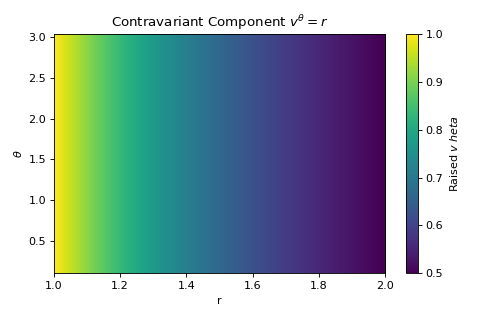differential_geometry.dense_utils.dense_raise_index#
- differential_geometry.dense_utils.dense_raise_index(tensor_field: ndarray, index: int, rank: int, inverse_metric_field: ndarray, out: ndarray | None = None, **kwargs) ndarray[source]#
Raise a specified index of a tensor field using the inverse metric tensor.
- Parameters:
tensor_field (
numpy.ndarray) –The tensor field whose index signature is to be adjusted. The array should have shape
(F₁, ..., F_m, I₁, ..., I_r), where:(F₁, ..., F_m)are the field (spatial or grid) dimensions,(I₁, ..., I_r)are the tensor index dimensions, andr is the tensor rank (i.e., the number of tensor indices, inferred from tensor_signature).
index (
int) – The index to lower, ranging from0torank-1.rank (
int) – The tensor rank (number of tensor indices, not including grid dimensions).inverse_metric_field (
numpy.ndarray, optional) –The inverse metric tensor used to raise covariant indices. This can be either:
A full inverse metric of shape (…, N, N), or
A diagonal inverse metric of shape (…, N).
Must match the metric type (diagonal vs full) and be broadcast-compatible with tensor_field.
out (
numpy.ndarray, optional) – Optional output array to store the result. If provided, must have the same shape and dtype as the expected output, and will be used for in-place storage.
- Returns:
A tensor field with the specified index raised. Has the same shape as tensor_field.
- Return type:
- Raises:
ValueError – If the input shapes or indices are invalid.
Examples
In spherical coordinates, if you have a covariant vector:
\[{\bf v} = r {\bf e}^\theta\]Then the contravariant version is:
\[v^\theta = g^{\theta \mu} v_\mu = g^{\theta \theta} v_\theta = \frac{1}{r^2} v_{\theta} = \frac{1}{r}.\]Let’s see this work in practice:
>>> import numpy as np >>> from pymetric.differential_geometry.dense_utils import dense_raise_index >>> >>> # Construct the vector field at a point. >>> # We'll need the metric (inverse) and the vector field at the point. >>> r,theta = 2,np.pi/4 >>> v_cov = np.asarray([0,r,0]) >>> >>> # Construct the metric tensor. >>> g_inv = np.diag([1, 1 / r**2, 1 / (r**2 * np.sin(theta)**2)]) >>> >>> # Now we can use the inverse metric to raise the tensor index. >>> dense_raise_index(v_cov, index=0, rank=1, inverse_metric_field=g_inv) array([0. , 0.5, 0. ])
A 2D example on a spherical grid:
>>> import numpy as np >>> import matplotlib.pyplot as plt >>> from pymetric.differential_geometry.dense_utils import dense_raise_index >>> >>> # Define 2D spherical grid >>> r = np.linspace(1, 2, 100) >>> theta = np.linspace(0.1, np.pi - 0.1, 100) >>> R, THETA = np.meshgrid(r, theta, indexing="ij") >>> >>> # Define a covariant vector field: v_θ = R >>> v_cov = np.zeros(R.shape + (2,)) >>> v_cov[..., 1] = R # non-zero only in theta direction >>> >>> # Define the inverse metric: g^{rr} = 1, g^{θθ} = 1 / r^2 >>> g_inv = np.zeros(R.shape + (2,)) >>> g_inv[..., 0] = 1 >>> g_inv[..., 1] = 1 / R**2 >>> >>> # Raise the index >>> v_contra = dense_raise_index(v_cov, index=0, rank=1, inverse_metric_field=g_inv) >>> >>> # Plot the raised θ-component >>> _ = plt.figure(figsize=(6, 4)) >>> im = plt.imshow(v_contra[..., 1].T, extent=[1, 2, 0.1, np.pi - 0.1], aspect="auto", origin="lower") >>> _ = plt.colorbar(im, label="Raised $v^\theta$") >>> _ = plt.xlabel("r") >>> _ = plt.ylabel(r"$\theta$") >>> _ = plt.title(r"Contravariant Component $v^\theta = r$") >>> _ = plt.tight_layout() >>> _ = plt.show()
(
Source code,png,hires.png,pdf)